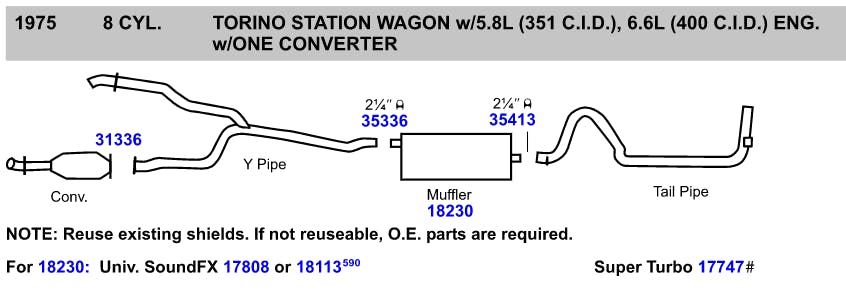Media | Articles
Piston Slap: The Gran Torino’s exhausting history with a Sable’s solution

Michael writes:
I’m looking for a good resource to restore my 1975 Ford Gran Torino to the OEM single exhaust with the original catalytic converter. The car was modified by its prior owner to dual exhaust, and I’m trying to restore the car to what it was when my grandmother bought it new after retiring from Ford. Can you provide direction?
Sajeev answers:
As a Malaise-era Ford nerd, stuff like this is right up my alley, so I shall do my best.
The story of the catalytic convertor is fascinating, with an evolution since 1975 that’s nothing short of monumental. Finding the GEN I catalytic convertor used on 1975 Ford vehicles was impossible online, but I remained optimistic that the rest of the system was available via the Walker catalog.
Marketplace
Buy and sell classics with confidence

Unfortunately, it gives line drawings with no part numbers for the piping. Even worse, the drawings suggest only one bank of cylinders fed the catalyst? Not a good sign, so in order to be 100 percent correct, getting the factory exhaust from manifolds to tailpipe is now in your hands: Contact national NOS parts vendors, make an eBay saved search for Ford part numbers starting with “D5oz” (look what I just found!), and have enough patience to fill the back of a Gran Torino Squire.
But what if you just want an exhaust that kinda looks correct? The pipes can be made locally out of 2-inch (if memory serves me) diameter tubes, and make sure they crush bend it so it looks awful and truly factory correct. Use the Walker screenshot above (or get a Ford shop manual for better photos), buy a modern muffler and catalytic convertor (a good idea for performance), and find an exhaust shop that appreciates your project just as much as I do. Making this happen is easy enough, provided you don’t need to struggle searching for NOS vintage Ford parts.
Bonus! An update on a previous Piston Slap:

Ryan writes:
I managed to fix the Sandlewood Sable LS, and it is currently running with all of the same parts. The problem was definitely in the IRCM, and it was a relay for the A/C compressor that was in a closed position and basically robbing the fuel pump relay of power. I removed the faulty relay from the circuit board by de-soldering the pins, but the fuel pump was not getting power without the relay on the board, so I re-installed it and then everything worked fine. Maybe the relay had been stuck in a closed position and wasn’t freed until it was removed or installed from the board. That’s the best explanation I can come up with: I had ordered a replacement IRCM and installed it, but that didn’t fix the problem. As you can see in the photo, it didn’t look anything like the original pink circuit board with brown relays, and I’m sure that it was intended to work with a later-year vehicle.

I think for now I’m going to need to carry a toggle switch, wires, and tools in the car just in case this happens again, and if it does I’ll replace the Siemens relays with Bosch relays. Right now, a replacement 1988 or older IRCM is virtually obsolete.
Have a question you’d like answered on Piston Slap? Send your queries to pistonslap@hagerty.com, give us as much detail as possible so we can help! If you need an expedited resolution, make a post on the Hagerty Community!





My cousin boy friend has one just like yours same color and all just sitting in the yard